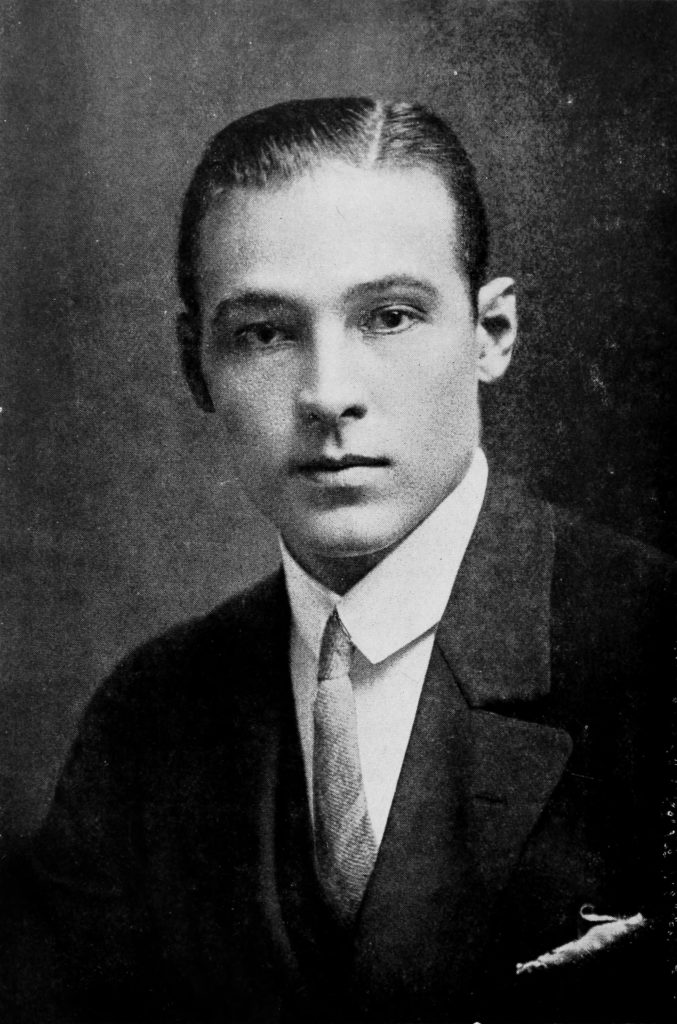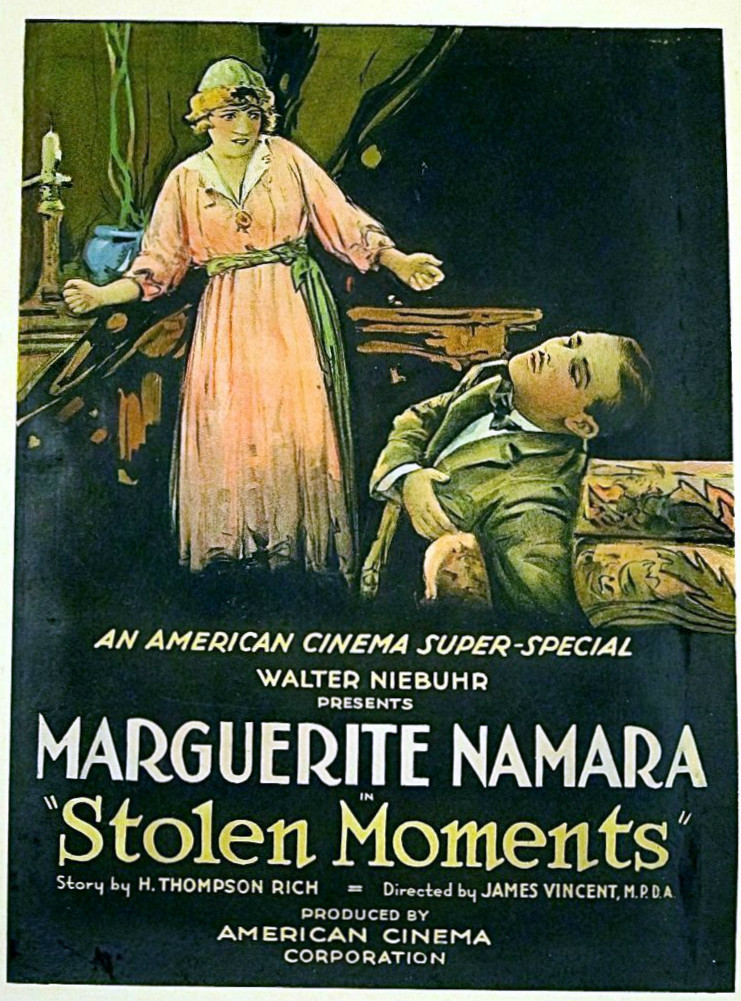
By Cassandra Geraghty @ayearofsilents
Imagine walking down St. George Street in Downtown Saint Augustine and bumping into matinee idol Rudolph Valentino. If you were lucky enough to catch him at the cusp of greatness, filming 1920s “Stolen Moments” you would have seen the up and coming star just months before he catapulted to celebrity status. But back then, during that four day shoot, he would have just been an unknown, “Rudolfo”.
Rodolpho Alfonso Raffaello Pierre Filiberto Guglielmi di Valentina D’Antolivella (phew!) was born in Italy in 1895 to a doting French mother and an Italian father who died of malaria when Valentino was eleven. After struggling through school and unable to find steady work, he decided to try his luck in America, arriving at Ellis Island at eighteen.
 Valentino was quickly hired to dance the tango at restaurants for $50/week. His dashing good looks found him embroiled in a scandal with Chilean heiress Blanca de Saulles, a “friend”, who called him to testify in her divorce case. In retaliation, her husband pulled some strings and had Valentino arrested. Although nothing came of the charges, his reputation in New York was tarnished and his pride wounded. When Blanca then shot and killed her now ex-husband over a custody battle, Valentino fled New York and headed west, changing his name to Rudolph Valentino.
Valentino was quickly hired to dance the tango at restaurants for $50/week. His dashing good looks found him embroiled in a scandal with Chilean heiress Blanca de Saulles, a “friend”, who called him to testify in her divorce case. In retaliation, her husband pulled some strings and had Valentino arrested. Although nothing came of the charges, his reputation in New York was tarnished and his pride wounded. When Blanca then shot and killed her now ex-husband over a custody battle, Valentino fled New York and headed west, changing his name to Rudolph Valentino.
Valentino worked in small theatre productions until he found his way to Los Angeles, where he continued his dancing career and began getting bit parts in films, predominantly villains and thugs. In 1919 he had a short-lived marriage to actress Jean Acker that ended with her locking him out of the bedroom on their wedding night. They immediately separated afterwards.
Valentino found himself in Saint Augustine in 1920 to film “Stolen Moments” for the American Cinema Company. At the time, Saint Augustine was a popular destination for silent film shoots, particularly with exterior film shots of tropical scenery. While only in town for four days, Valentino filmed scenes in the courtyard of the Hotel Ponce de Leon (now Flagler College), Villa Zorayda and Fort Marion (Castillo de San Marcos) and he and the crew stayed at the St. George Hotel. Considered otherwise unexceptional, it was the last film in which Valentino was cast as a villain. Although it was released with little fanfare, his following film “The Four Horsemen of the Apocalypse” was one of the highest grossing silent films of all time. The film gained $1M in box office sales and solidified Valentino’s credibility in film history. Because of the film’s popularity, “Stolen Moments” was re-released in theaters.
 Rudolph Valentino met Natacha Rambova (born Winifred Kimball Shaughnessy!!), a costume designer, on the set of “Uncharted Seas” in 1921 and they worked together in Alla Nazimova’s “Camille”, becoming romantically involved. Around this time Valentino ended his relationship with Metro Pictures who he felt never treated him like the star his box office sales would show he was. Instead he went over to Famous Players-Lasky (now Paramount Pictures) who nurtured his Latin Lover image. In 1921 he filmed the hugely popular films “The Sheik” and “Beyond the Rocks” with Gloria Swanson.
Rudolph Valentino met Natacha Rambova (born Winifred Kimball Shaughnessy!!), a costume designer, on the set of “Uncharted Seas” in 1921 and they worked together in Alla Nazimova’s “Camille”, becoming romantically involved. Around this time Valentino ended his relationship with Metro Pictures who he felt never treated him like the star his box office sales would show he was. Instead he went over to Famous Players-Lasky (now Paramount Pictures) who nurtured his Latin Lover image. In 1921 he filmed the hugely popular films “The Sheik” and “Beyond the Rocks” with Gloria Swanson.
The following year, Valentino and Natacha wed, causing a huge scandal and bigamy trial since he did not wait the proper amount of time after his divorce from Jean Acker. The two were forced to annul their marriage and live separately for a year before they could try again although the two were often seen together. That same year, Valentino filmed “Blood and Sand” with Nita Naldi which he considered his best role. Feeling he was not receiving wages comparable to his level of stardom or the creative control he desired, Valentino went on strike from Famous Players. Meanwhile, he went on a hugely successful 88 city dance tour with Natacha, his now wife, called the Mineralava Dance Tour in 1923.
In 1924 Valentino returned from his dance tour to finish up his contract with Famous Players. No films brought the success “Four Horsemen” and “The Sheik” had brought but “Monsieur Beaucaire” with Bebe Daniels got the attention of Charlie Chaplin and Douglas Fairbanks who wooed him over to United Artists with a more lucrative contract. The only condition was that Natacha, who had a reputation for being controlling and opinionated, was barred from set. Valentino signed the contract and Natacha packed her bags. They divorced in 1925 and it was so bitter that he left her $1 in his will.
 While filming his next production, “The Son of the Sheik” he began feeling ill. While doing press for the film in New York City, on August 15, 1926, Valentino collapsed and was taken to the hospital with ulcers and appendicitis. According to his brother, the urgent care was delayed while the studios searched for the best surgeon possible. On August 21, Valentino’s health deteriorated and, although he was under the impression that he was going to pull through, he passed away on August 23rd at the age of 31.
While filming his next production, “The Son of the Sheik” he began feeling ill. While doing press for the film in New York City, on August 15, 1926, Valentino collapsed and was taken to the hospital with ulcers and appendicitis. According to his brother, the urgent care was delayed while the studios searched for the best surgeon possible. On August 21, Valentino’s health deteriorated and, although he was under the impression that he was going to pull through, he passed away on August 23rd at the age of 31.
His death caused mass hysteria with 100,000 spectators swarming around his funeral and causing riots. Pola Negri, an actress he had been casually dating made a spectacle of herself at his funeral, famously fainting and claiming they had been engaged. A train procession then took his body to Los Angeles where he was ultimately buried.
Rudolph Valentino has reached legend status, with his dashing looks and his tragic death at such a young age, ladies are still swooning almost 100 years later. With films like “The Four Horsemen of the Apocalypse” he proved that he was not just a pretty face but a compelling performer who deserves his place in film history.




Really interesting as it gives more details about a rarely mentioned trip….wonder where the bottom photo was taken??